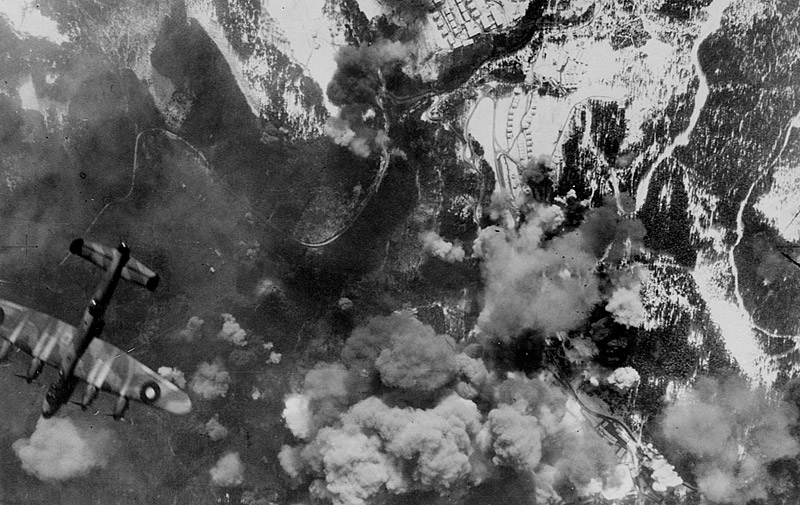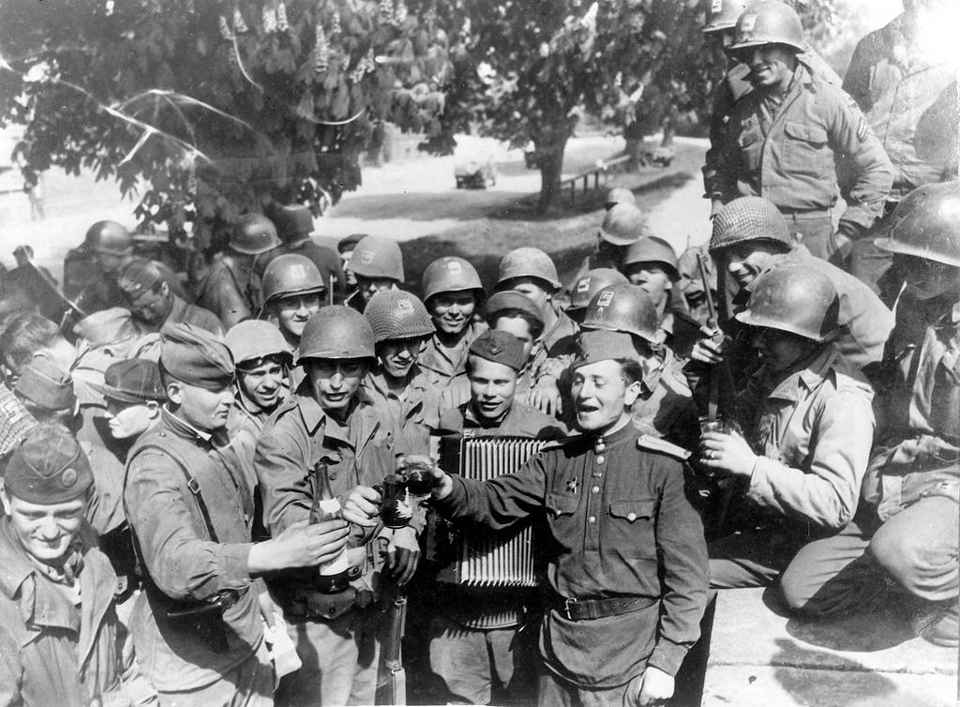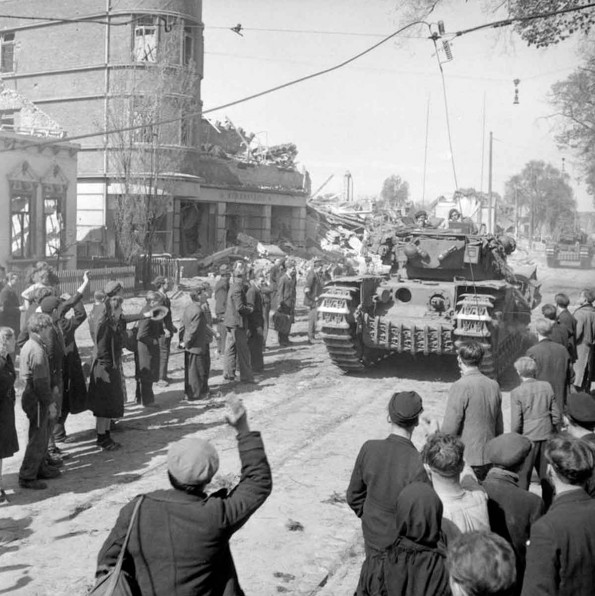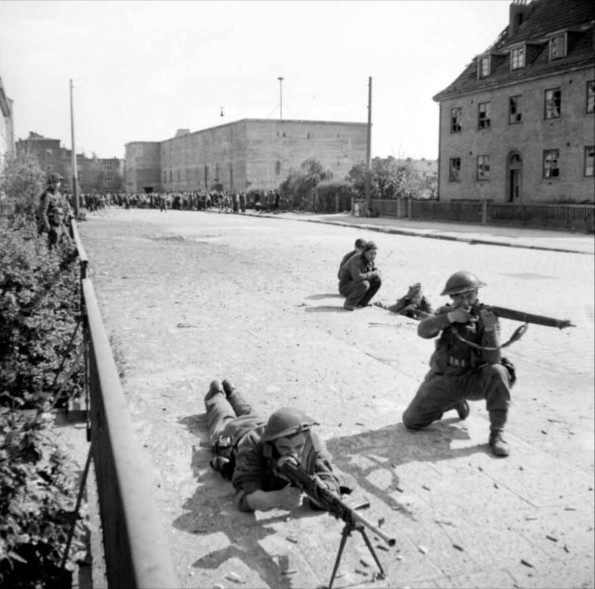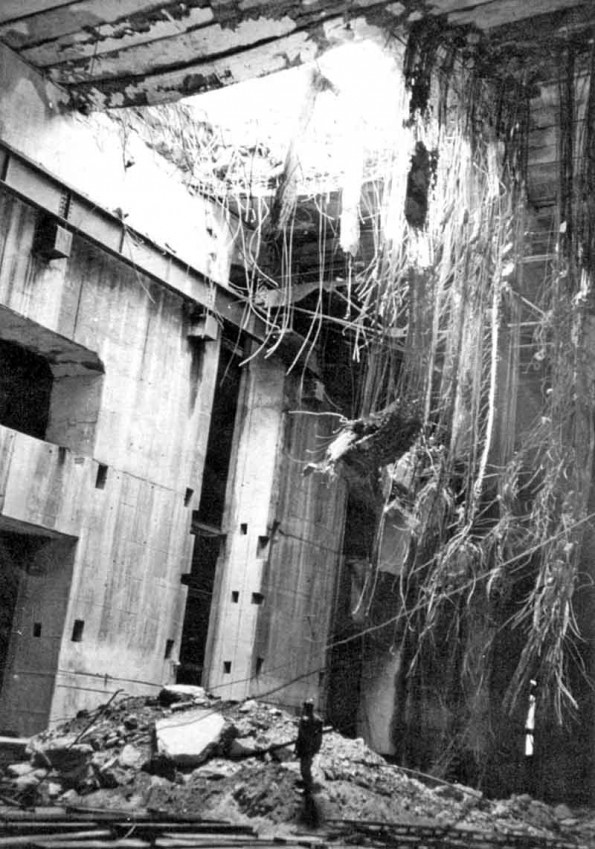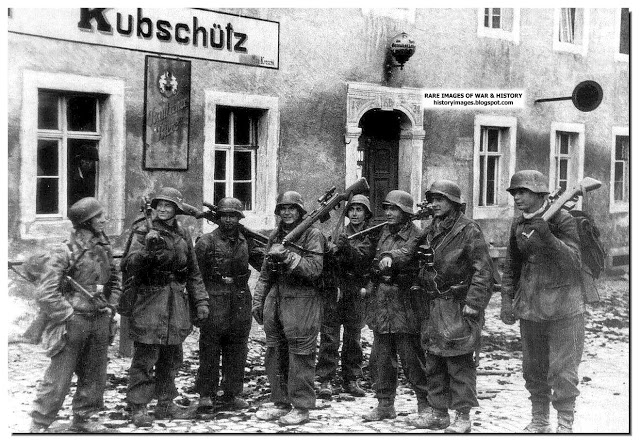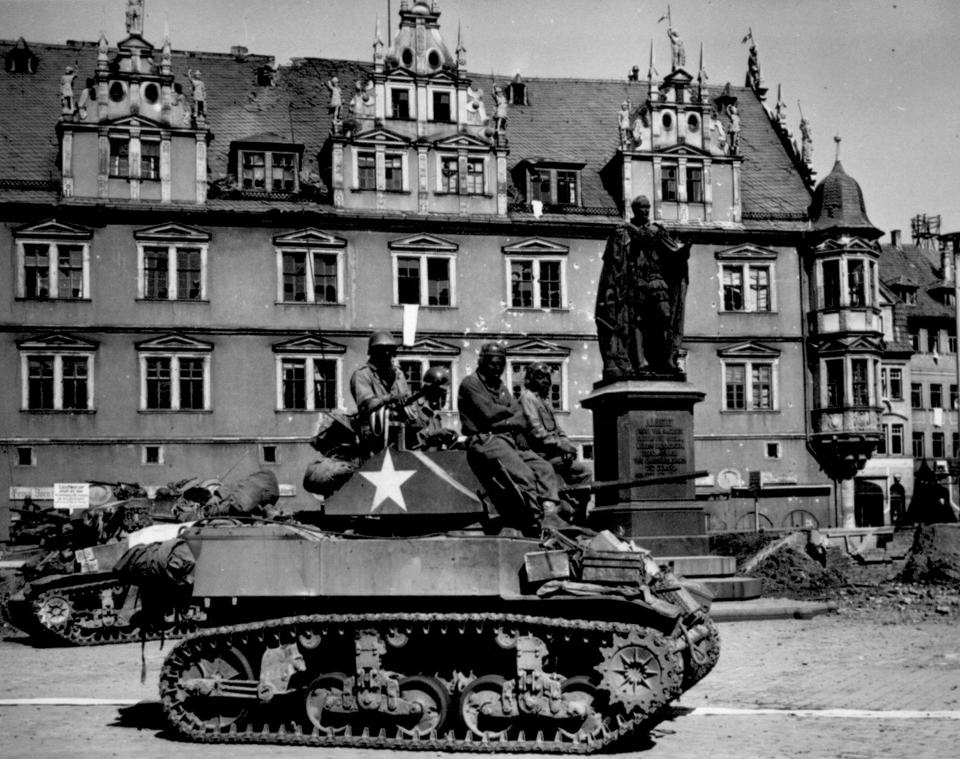Air Operations, CBI
BURMA- 20 459th Fighter Squadron P-38s attack troops across the central Burma battle area.
- 16 P-38s attack dumps, supplies, and motor vehicles at Hopong and Hotang.
- 4 341st Medium Bomb Group B-25s and 4 14th Air Force P-47s attack anti-aircraft batteries and a bridge near Anyang.
- More than 50 P-47s and P-51s attack numerous road, rail, and river targets.
- 2 308th Heavy Bomb Group B-24s attack rail yards at Hongay.
- 46 90th and 380th Heavy Bomb group B-24s attack port facilities and an alcohol plant at Saigon.
Air Operations, East Indies
- XIII Bomber Command B-24s attack the Boeloedowang airfield on Celebes.
- Fleet Air Wing 10 PVs attack various targets on Borneo.
Air Operations, Europe
RAF BOMBER COMMANDDaylight Ops:
- 482 aircraft including 308 Halifaxes, 158 Lancasters and 16 Mosquitos of Nos. 4, 6 and 8 Groups are sent to attack Wangerooge. The raid is intended to knock out the coastal batteries on this Frisian island which controls the approaches to the ports of Bremen and Wilhelmshaven. No doubt the experience of Antwerp, when guns on the approaches had prevented the port being used for several weeks, prompted this raid. The weather is clear and bombing is accurate until smoke and dust obscure the target area. The areas around the batteries are pitted with craters, but the concreted gun positions are 'hardly damaged'. They are all capable of firing within a few hours. Part of the bombing hits a camp for forced workers and the holiday resort and many buildings are destroyed, including several hotels and guest houses, the Catholic church and two children's holiday homes, although these do not appear to have been occupied at the time of the bombing.
- 5 Halifaxes and 2 Lancasters are lost.
- 6 of the 7 bombers lost are involved in collisions: 2 Halifaxes of No. 76 Squadron, 2 Lancasters of No. 431 Squadron and 2 Halifaxes of Nos 408 and 426 Squadrons, both from Leeming airfield. There is only 1 survivor, from one of the No. 76 Squadron aircraft. 28 Canadian and 13 British airmen are killed in the collisions. The seventh aircraft lost is a Halifax of No. 347 (Free French) Squadron whose crew are all killed.
- 359 Lancasters and 16 Mosquitos of Nos. 1, 5 and 8 Groups are sent to bomb Berchtesgaden. This raid Is against Hitler's 'Eagle's Nest' chalet and the local SS guard barracks. Among the force are 16 Lancasters of No. 617 Squadron dropping their last Tallboys. 8 Oboe Mosquitos are also among the bombing force, to help with the marking, but mountains intervene between one of the ground stations transmitting the Oboe signals and the Mosquitos can not operate even though they are flying at 39,000 ft. There is some mist and the presence of snow on the ground also make it difficult to identify targets, but the bombing appears to be accurate and effective. No other details are available.
- 2 Lancasters are lost.
- Most of the squadrons taking part in the raids on this day were flying their last operations of the war.
- 107 Lancasters and 12 Mosquitos of No. 5 Group attack the oil refinery in Tonsberg in Southern Norway in the last raid flown by heavy bombers. The attack is accurately carried out and the target is severely damaged.
- A Lancaster of No. 463 Squadron comes down in Sweden, the last of more than 3,300 Lancasters lost in the war. Flying Officer A. Cox and his all-British crew all survive and are interned in Sweden until the end of the war, only a few days away.
- 82 Mosquitos are sent to Pasing airfield and 18 to Kiel, 14 Lancasters lay mines in Oslo Fjord in the last minelaying operation of the war, 12 Mosquitos of No. 8 Group drop leaflets over prisoner-of-war camps, and there are 35 Mosquito patrols and 9 RCM sorties.
CZECHOSLOVAKIA:
- 279 1st Air Division B-17s attack the airfield and munitions factory at Pilsen.
- 6 B-17s and 1 of 539 VIII Fighter Command escorts are lost to flak.
- The last unit to drop its bombs--and thus the last 8th Air Force heavy bomber unit to drop bombs in World War II--is the 41st Combat Bomb Wing's 384th Heavy Bomb Group.
- 78th Fighter Group P-51 pilots set the USAAF record for enemy aircraft destroyed on the ground by strafing: 135 in one day.
- 278 2nd Air Division B-24s attack three rail targets and an electric-transformer station in Bavaria.
GERMANY:
- 296 9th Air Division bombers attack the Erding Airdrome and an ordnance depot. This mission marks the last appearance of Luftwaffe jet fighters against 9th Air Force bombers, and it turns out to be the last mission of the 323rd and 344th Medium Bomb Groups and the 410th Light Bomb Group.
ITALY:
- The entire 12th Air Force is committed to halting or slowing the retreat of German Army forces in northern Italy.
- 12th Air Force B-25s attack an Adige River crossing point, a marshalling yard, and five bridges and a rail fill on the Brenner Pass line on both sides of the Austro-Italian frontier.
- XXII TAC P-47s and 15th Air Force P-38s and P-51s attack a wide variety of tactical targets and lines of communication.
- During the night, XXII TAC A-20s, A-26s, and P-47s attack airfields, marshalling yards, road targets, and lines of communication in the northern Po River valley.
ITALY:
- 15th Air Force heavy bombers attack several targets at the vital rail center at Linz and the marshalling yard at Wels.
Air Operations, Formosa
5 3rd Light Bomb Group A-20s destroy a sugar refinery at Taito.
[Air Operations, Philippines
- FEAF B-24s attack the Basco airfield on Batan and bridges in Balete Pass.
- V Bomber Command B-25s, A-20s, and V Fighter Command fighter-bombers mount intense attacks throughout Luzon.
- 1st Marine Aircraft Wing PBJs, SBDs, and F4Us support the US X Corps on Mindanao.
Air Operations, Ryukyus
- US Navy and Marine Corps aircraft support the US 10th Army on Okinawa.
- Task Unit 52.1.3 TBMs and F6Fs attack airfields in the Sakishima Islands.
Battle of the Atlantic
The German submarine U-326 is sunk in an attack by Liberator 'K' of VP-103 southwest of the Brest peninsula.
| Class | Type VIC |
| CO | Oberleutnant zur See Peter Matthes |
| Location | Atlantic, SW of Ushant |
| Cause | Air attack |
| Casualties | 44 |
| Survivors | None |
Burma
In the Irrawaddy Valley mopping up operations continue. Salin is captured by the British forces. The main XXXIII Corps advance is closing in on Allanmyo. The spectacular progress of the 5th Indian Div in the Sittang Valley continues with the capture of Perwegen. The Japanese forces around Rangoon and in other parts of southern Burma are beginning to withdraw through Pegu to the east so as to be able to retreat into Thailand.
[China
On the flanks of the main Japanese column heading for Chihchiang, the Chinese 58th Div is forced to withdraw and yield the town of Wukang.
[Eastern Front
Berlin is completely encircled by the Russians. At Torgau, on the Elbe south of Berlin, the 5th Guards Army, 1st Ukraine Front, makes first contact with the Americans of the 1st Army. The whole of Germany in now cut in two.
The 1st Belorussian Front and the 1st Ukraine Front join up northwest of Potsdam, near Ketzin. German headquarters announce that there is fighting in this area and near Nauen. South of the capital the Russians thrust ahead to a line Neubabelsberg-Zehlendorf-Neukölln and in the north there is fighting near Oranienburg.
Meanwhile the Russian troops are engaged in severe fighting with the Guben-Frankfurt group, consisting of the 9th Army and part of the 4th Panzer Army, south of Fürstenwalde. The group is never to get to Berlin nor are the Steiner operational group, or Gen Walther Wenck's army.
In East Prussia, the 3rd Belorussian Front overcomes the Germans defending Pillau. What is left of the German forces takes refuge in the narrow strip of land connecting the Samland peninsula to Danzig.
On the Czechoslovak front, forces of the 2nd Ukraine Front reach the outskirts of Brno, an important center of armaments production.
In northwest Dalmatia, Tito's troops reach the area of Fiume.
The Germans, with a strength born of desperation, still manage to launch the occasional counterattack. Their 17th Army, for instance, succeeds in breaking through the lines of the 1st Ukraine Front in the area of Görltiz-Bautzen-Kamenz, south of Cottbus, inflicting heavy losses on the Russians.
In East Prussia Pillau is taken. There are still a few German troops holding out at the tip of the Samland Peninsula. Since early in the year 140,000 wounded and 40,000 refugees have been evacuated to the west from Pillau.
EAST PRUSSIAPillau falls to the 3rd Belorussian Front, which has suffered 89,400 killed and 332,000 wounded since January.
GERMANYThe Soviet 4th Guards Tank and 47th Armies link up at Potsdam. The 5th Guards Army has reached the Elbe River at Torgau, splitting Germany in two.[MORE]
[Italy
While units of the IV Corps, US 5th Army, take Villafranca airport at Verona, 10th Mountain Div, and Parma, 3rd Div, the 88th Div, II Corps, liberates Verona. In the British 8th Army sector, the 56th Div and the Italian Cremona Combat Group cross the Po at Polesella and near the coast. The naval base at La Spezia on the Ligurian coast is captured by the Allies.
The German resistance begins to collapse and large-scale surrenders begin. The extensive partisan operations are extended by risings in Milan and Genoa.
[Okinawa
Powerful aerial, naval and artillery bombardment by the Americans continues against the main positions of the Shuri line.
Two US ships are damaged in a collision, the escort carrier Steamer Bay (CVE-87) and the destroyer Hale (DD-642).
[Pacific
- The Japanese submarine RO-109 is sunk by the US high-speed transport Horace A. Bass (APD-124) in the Philippine Sea area.
- The Japanese minesweeper No. 41 is sunk by the US submarine Cod (SS-224) off China.
Philippines
On Luzon in the US I Corps sector the attack begins on Mount Mirador, near Baguio. Operations continue against Mount Pacawagan, in the XI Corps sector, and Mount Mataasna Bundoc and the Cituinan hills in the XVI Corps sector. During the night the Japanese begin to withdraw from the Cituinan hills.
[Western Front
The US 3rd Army continues its offensive in the direction of the Czechoslovak frontier and moves south of the Danube with the XX and III Corps. The US 7th Army, engaged along the Danube, crosses the river at several points north and south of the Dillingen bridgehead.
In the French 1st Army sector, the II Corps advances eastward from the Sigmaringen area; the French I Corps is engaged by the remaining units of the German 19th Army, making a last desperate attempt to escape into the Bavarian Alps and concentrate its forces in the Black Forest before launching an offensive between Villengen and the Swiss frontier.
The US 1st Army meets up with the Soviet forces at Torgau on the Elbe.
[World Affairs
A conference begins at San Francisco to draw up the constitution of a United Nations Organization. It will last about 2 months. It is decided that the UN should have a General Assembly of all nations and as a recognition of the difficulty and importance of unanimity among the major nations of a Security Council in which the great powers would have permanent seats and the power to veto. The permanent members of the Security Council are to be the United States, the Soviet Union, Britain, France and China. The Soviets have been among the stronger advocates of the major powers having a veto because they expect that they will be consistently outvoted by the memberships of the organization as it will stand at first. As well as the main bodies for international debate and peace keeping, there are proposals for the creation of an International Court of Justice and specialized social and economic agencies.
The text of the Charter of the United Nations is completed on June 23, formally approved on the 25th and signed on the 26th.
[Images from April 25, 1945
|
|
|
|
|
|
|
|
Guarding a Corner of a German POW Camp |
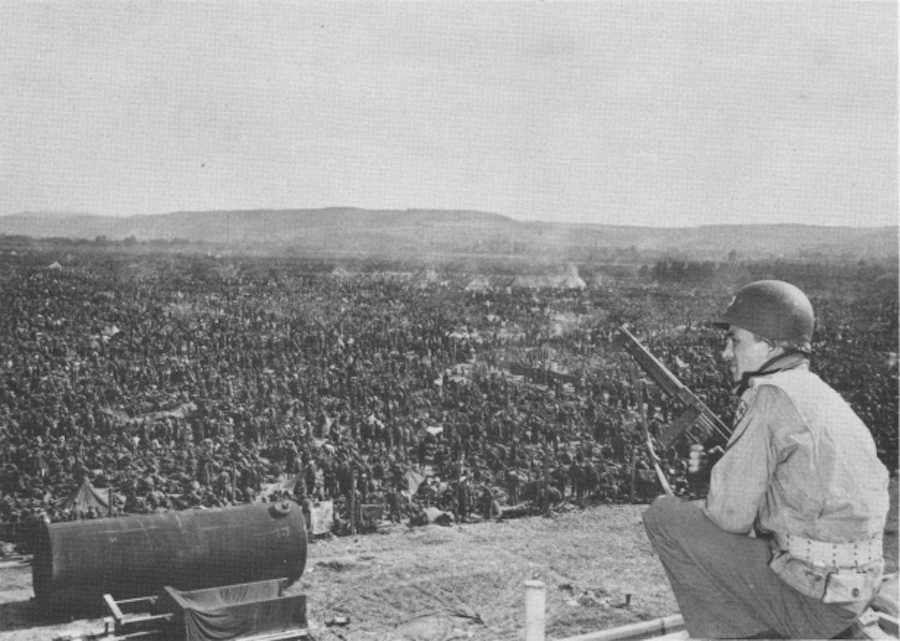 |
